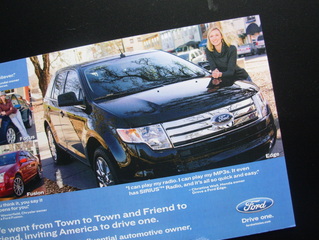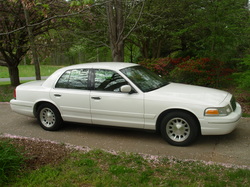 photo copyright Brian E. Faulkner
photo copyright Brian E. Faulkner Why?
They are cautious, deliberate decision makers, which is one reason they’re successful in a business category that can be fragmented and undifferentiated. Their decision to put off adopting the new tagline, therefore, was in keeping with their conservative management style.
Even so, it reminded me of my father, who my mother once said could spend six months thinking about whether to purchase a $500 used car (back when five C-notes could buy a decent set of wheels). Invariably, by the time he made up his mind, the car had long since been sold. Mom was optimistic from the get-go (like I tend to be). Dad was careful (like my client). There was only one time in their lives when he truly abandoned his way in favor of hers: the purchase of Mom’s Florida dream house only days after they first laid eyes on the place, where they then lived happily for nearly 20 years.
Was my client in danger of missing out on the new tagline while they thought about it? No, although not because a competitor would have snatched it up, but because it’s unlikely that anybody would have come up with the unique combination of words that fit that particular business/customer situation.
My point here is not about the failure of a client to adopt my tagline recommendation. Rather, I’m suggesting that sometimes it takes courage to change, to break out of your comfort zone and declare new competitive space. Truth is, these guys could have gone on for the rest of their business lives, not changed their tagline and still been successful because they had so many good things going for them. They did great work and lived out their integrity every day, which is why their customers recommend them to friends and family.
But if they plan on expanding geographically, into locales where nobody knows their name (a stated goal back then), that moment may have been the most opportune time to soup up their tagline and possibly even change their locally-oriented business name to something a future marketplace could grab onto more readily. As it turned out, they also had been considering a wholly different move: staying local and buying into a national franchise, which they eventually pulled the trigger on, complete with the prepackaged franchise tagline. But another reason they were reluctant to change, I contend, is because change is tough. It’s hard to cast aside something familiar and comfortable in favor of something new – whatever it may be.
Again … change is tough. Almost every serious personal or business blunder that I’ve made can be traced to my lack of courage to face some necessary change – primarily in myself. It takes courage to look your truth in the eye, to take an unvarnished look at the “real” you, the one that others probably can see better than the person in the mirror can. Somebody else's truth is always easier to see, but it’s your truth that’s trying to get your attention. Unfortunately, even lab rats are said to learn new ways more readily than people.
Leadership consultant Dusty Staub offers up The 7 Acts of Courage:
1. The courage to dream and put forth your dream.
2. The courage to see current reality. (the really tough one)
3. The courage to confront. (difficult for some of us)
4. The courage to be confronted. (even more difficult)
5. The courage to learn and grow.
6. The courage to be vulnerable (to love).
7. The courage to act.
Dusty claims that it’s all about living in a “wholehearted,” authentic (truth-full) way, beginning with his first Act: being honest about (and consecrating) your purpose.
“I say yes to those things that take me deeper into what’s most important,” he says. “And I begin to say no to the things that take me away from what’s most important.” That’s learning to be real.
In Margery Williams’ lovely children’s story, The Velveteen Rabbit, a worn out old stuffed bunny yearns to be a real rabbit but doesn’t quote know how to go about it.
“Does it mean having things that buzz inside you and a stick-out handle?” he asks his stuffed nursery companion. “Real isn’t how you’re made,” replies the friend, “it’s a thing that happens to you.”
But real life is not story-time magic. Coping with the grit of today and the challenges of tomorrow can be rough business. The kind of honest transformation we’re talking about here may, in fact, be the hardest work you will ever do, whether that means confronting business realities or your self (dying to old ways can be extraordinarily difficult). Find a guide to help you along the way. Believe. Persevere. And things more than likely will get better – perhaps in ways that seem unimaginable to you now. Ignore these hidden realities, however, and you’re likely to see familiar old issues come back to bite you in the backside again and again. Or you may miss out on some future opportunity that passes you by because you didn’t do the hard work of change early on.
There isn’t enough space here to dig more deeply into Dusty Staub’s 7 Acts, which are about seeing, changing and living with integrity, whether the task is to look your business more squarely in the eye and finally make the changes you need to make, or to work on your personal life. In either case, the objective is the same: authenticity. The reward? A more wholehearted, more “real” and fulfilling personal or business life – perhaps reflected in a compelling new customer-focused tagline for your brand or a personal dream that you finally find the guts to state openly for the first time in your life. The words you choose will help light the way, because they are energized with purpose and power … because they are true.
Takeaway: Do you have the courage to face the truth of your business or personal realities?
Do you have what it takes to change?






 RSS Feed
RSS Feed